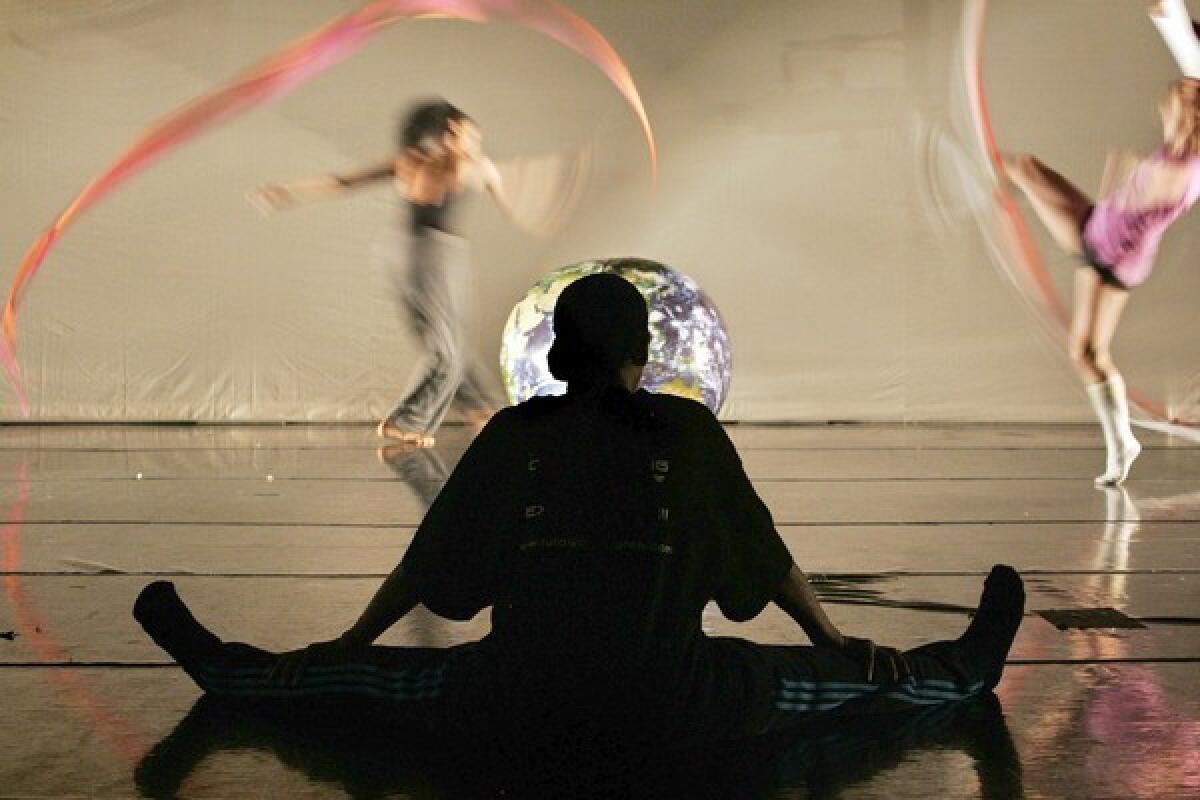Lula Washington: A life changed by dance

- Share via
“There is no gum chewing allowed anywhere inside Lula Washington Dance Theatre,” a sign warns on the dance academy’s front door. Dwarfed by the big-box retail stores of Crenshaw Boulevard, the unassuming low-rise shell belies its explosive contents -- dance, music, kids, creativity. Enter the House That Lula Built, headquarters for Washington’s school and her touring modern dance troupe and a place where you’d better leave fooling around on the sidewalk.
Washington, 59, is Los Angeles’ best-known African American choreographer, a community organizer and an advocate for the arts. She takes dancing dead seriously. Directing one of the few companies in the region that commands national attention, Washington is celebrating her troupe’s 30th anniversary this year.
Over her career, she’s seen the funding environment for the arts deteriorate to a climate that can be described only as hostile.
And yet she survives, initiating new projects as a concert dance maker and lately in film.
She’s riding high since choreographing the movements for the Na’vis in “Avatar.” And her company has bookings from New Mexico to New Jersey as well as L.A. dates this week at the Cerritos Center for the Performing Arts and later this year at the Luckman Fine Arts Complex, the Hollywood Bowl (with trumpeter Terence Blanchard) and at downtown’s Grand Performances.
That’s a lot of hustle.
In 2004, as she received California First Lady Maria Shriver’s Minerva Award for women’s achievement, the choreographer said, “Dance, for me, is life. You came into this world moving. Dance can change your whole life.”
Washington’s resolute tone offers clues to her staying power; her softness belies strong drive. It manifests in her 12-member touring ensemble, a multiracial tribe of real movers. It’s evident in her eye-popping choreographic mélange of jazz, funk and African-derived movement fused into theatrical modern dance. And it explains how she’s garnered top African American choreographers, notably Donald McKayle, Katherine Dunham, Donald Byrd, Louis Johnson, Rennie Harris and Christopher Huggins, to create dances for her troupe.
Beyond the concert stage, Washington’s brand is deeply associated with community involvement. The school’s annual Kwanzaa Celebration, now a Leimert Park Village holiday tradition, provides a robust outlet for neighborhood kids to channel energy while building self-esteem.
Every December for 19 years, Washington has unleashed a pageant of dance virtuosity on a packed house of beaming parents. The engaging performers, many with talent to burn, range from tap-dancing tots to the school’s Youth Dance Ensemble on pointe to some serious senior citizens in dashikis and turbans. Directing this wild cabaret is Tamica Washington-Miller, Washington’s daughter and protégée, who coaches from the wings as the three-hour show builds to its blistering finale: a squadron of percussionists propelling a half-hour of African dance.
A relative latecomer to dance, Washington grew up the oldest of eight kids in Watts’ Nickerson Gardens housing project. Only after she saw a UCLA performance of Alvin Ailey American Dance Theater at age 22 did the onetime nurse conceive of life as a dancer. She committed to her career with the spiritual support of two men: her husband, Erwin, a playwright and journalist who is now the company’s executive director (“I told her to pursue what she loves most in life and I’d take care of the money,” he remembers), and McKayle, a choreographer who was then working in film and television. He has since contributed several of his works to Washington’s troupe, adding historical weight to the repertoire.
Friends in high places sing her praises. Among them is “Avatar” filmmaker James Cameron. Seeking a movement language for his imagined world on the moon Pandora, he hired Washington to create a proprietary way of moving for the 10-foot-tall, blue-skinned members of his cast.
Cameron’s producer-partner Jon Landau says in a telephone interview: “Since our early days [developing ‘Avatar’] in 2006, we thought about bringing in a movement expert. But we wanted more than motion. We wanted emotion. Lula had the most insight into the motivation behind movement.”
In her first meeting with the director, Washington offered Cameron the “third eye” greeting, a light finger touch to the forehead by the Na’vis. Her familiarity with ritual got her the gig.
“We wanted movements that were original but had a touchstone of the familiar.” Landau said. “She said, ‘This gesture here is a sign of aggression; this gesture here is a sign of acceptance.’ A nod means something across cultures. We wanted to lose the nod and find other ways to express those emotions.”
Washington’s movement motifs pepper the film. The light head-bump greeting between Neytiri and Jake, the laying of hands on Jake when he is accepted into the tribe, the circular torso movement as the hand-holding Na’vis worship at the Tree of Souls, and Neytiri’s electric stag leap when the warrior goes on the hunt are all Washington’s invention.
Mo’at’s backward arch, her hands raised and vibrating, was performed by Washington-Miller in the motion capture process, but it was created by her mother.
According to Landau, having dancers on the set had a strong effect on the movie’s culture. “It was stimulating for the actors,” he said. “Going through the movement training with Lula helped everyone understand who the Na’vis are.”
Ten of Washington’s dancers participated in the film’s “performance capture” process, especially Washington-Miller, who, wired up, enacted Neytiri’s mother, Mo’at. Says Washington: “ ‘Avatar’ came at a good time for my company. It was a challenge, and I was grateful to work with James Cameron. I didn’t know how powerful ‘Avatar’ would be. I was just going to work!”
Another of Washington’s longtime supporters, Olga Garay, executive director of the Los Angeles Cultural Affairs Department, included Washington’s troupe at a recent showcase for L.A. artists at the International Book Fair in Guadalajara, Mexico. Says Garay, “We were thrilled that they went. There was a performance at an outdoor venue, with seating for 4,000, and the crowd went wild. It was a wonderful, invigorating performance, including [Donald McKayle’s] ‘Angelitos Negros,’ set to a Roberta Flack song sung in Spanish. The audience just loved it. Lula’s programming shows a level of outreach and sophistication that has made them one of the leading African American dance troupes in this country. Plus, they have a wonderful affinity for community.”
McKayle, now on leave from his post at UC Irvine to write a memoir, sits prominently on the Lula Washington Dance Theatre board of directors. McKayle has contributed “Songs of the Disinherited,” “Games,” “Rainbow Etudes” and “Death and Eros” to Washington’s repertory.
“They do a wonderful interpretation of ‘Games,’ ” he says. “Lula has had gifted interpreters. I’m very happy to lend my good name to her company. It’s amazing that they are finally settled in their own building, with parking. I’m proud that she’s made it this long.”
Recently, Washington is found rehearsing a new work, “www.connections.2010,” to music by the Rolling Stones and Michael Jackson’s “Earth Song.” She’s in the largest of four studios in her 14,500-square-foot building, where a family atmosphere prevails (toddlers are welcome, including the Washingtons’ two grandchildren). She calls her new piece “a rare time that I’ve used music that is that popular. I wanted my piece to connect to an event -- the death of Michael Jackson.”
The work, which concerns human connection in the Internet age, premieres this weekend at Montclair State University in New Jersey; next it will be performed in Cerritos. The characteristically sassy Lula Washington dancers, cellphones to ears and texting onstage, perform pas de deux with their PDAs.
Also at Cerritos will be “Love Is . . .,” a premiere by former Alvin Ailey dancer Huggins. Washington-Miller contributes an exploration of the sibling rivalry between tennis-playing sisters Venus and Serena Williams. At the Luckman, the program will include “Reign,” a new work by Philadelphia-based hip-hop king Harris.
Lula Washington’s dancers have performed at the Joyce Theater and Lincoln Center Out of Doors in New York and at the Kennedy Center in Washington. They’ve traveled to Kosovo, Germany, Spain and Mexico. Pending invitations to China, Russia and the Edinburgh Festival in Scotland will pull Lula Washington far from her base at Crenshaw Boulevard and Coliseum Street. And her ability to dream with Cameron catapulted her across the universe to the imagined land of Pandora. “Avatar’s” Landau says: “Lula is all about community in a global way. And the movie is about community in a global way. That’s why our relationship worked out so well.”
More to Read
The biggest entertainment stories
Get our big stories about Hollywood, film, television, music, arts, culture and more right in your inbox as soon as they publish.
You may occasionally receive promotional content from the Los Angeles Times.










